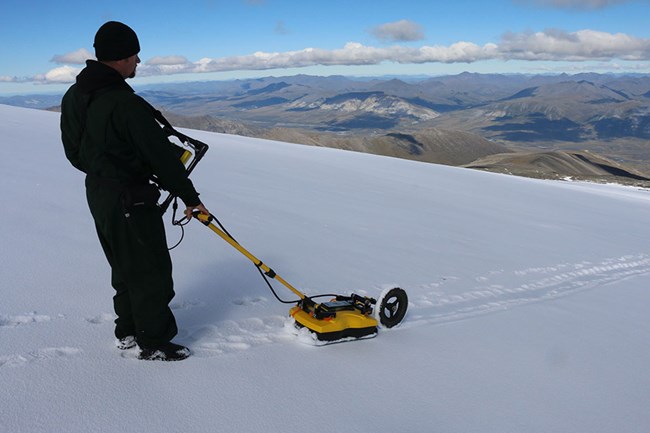Last updated: June 4, 2020
Article
Using ground-penetrating radar in Arctic archaeology

A team of NPS archaeologists used groundpenetrating radar and magnetometry to learn about archaeological resources in the Brooks Range. These tools let us see underneath the ground without digging and the potential to disturb or damage artifacts. In recent field work, we found a prehistoric tent ring at least 3,000 years old. We could see the remains of a skin tent and a ring of rocks that contained stone tools and an ancient fire hearth. The ice-patch phenomenon is not well known in the Brooks Range, and what we learned here is that this particular ice patch is more than 80 feet thick and consisted of many layers of ice as well as some rock.
Frozen: The potential and pitfalls of ground-penetrating radar for archaeology in the Alaskan Arctic
Abstract
Ground-penetrating radar (GPR) offers many advantages for assessing archaeological potential in frozen and partially frozen contexts in high latitude and alpine regions. These settings pose several challenges for GPR, including extreme velocity changes at the interface of frozen and active layers, cryogenic patterns resulting in anomalies that can easily be mistaken for cultural features, and the difficulty in accessing sites and deploying equipment in remote settings. In this study we discuss some of these challenges while highlighting the potential for this method by describing recent successful investigations with GPR in the region. We draw on cases from Bering Land Bridge National Preserve, Cape Krusenstern National Monument, Kobuk Valley National Park, and Gates of the Arctic National Park and Preserve. The sites required small aircraft accessibility with light equipment loads and minimal personnel. The substrates we investigate include coastal saturated active layer over permafrost, interior well-drained active layer over permafrost, a frozen thermo-karst lake, and an alpine ice patch. These examples demonstrate that GPR is effective at mapping semi-subterranean house remains in several contexts, including houses with no surface manifestation. GPR is also shown to be effective at mapping anomalies from the skeletal remains of a late Pleistocene mammoth frozen in ice. The potential for using GPR in ice and snow patch archaeology, an area of increasing interest with global environmental change exposing new material each year, is also demonstrated.
Urban, T. M., J. T. Rasic, C. Alix, D. D. Anderson, S. W. Manning, O. K. Mason, A. H. Tremayne, and C. B. Wolff. 2016. Frozen: the potential and pitfalls of ground-penetrating radar for archaeology in the Alaskan Arctic. Remote Sensing 8(12):1007
